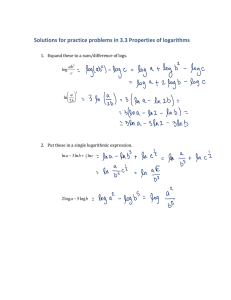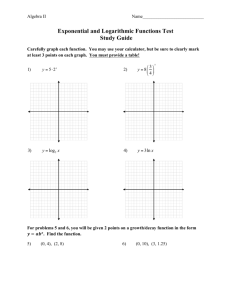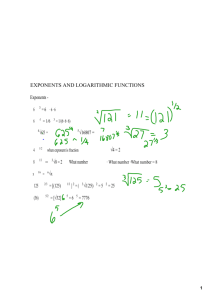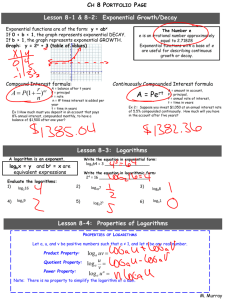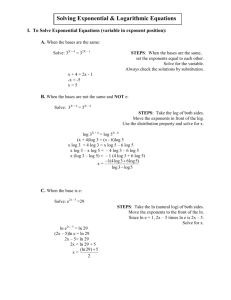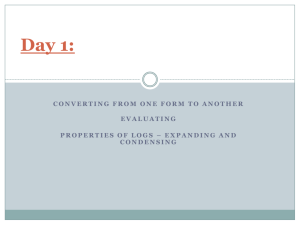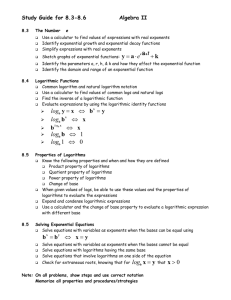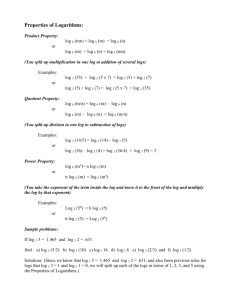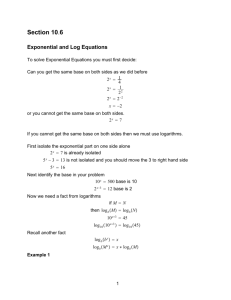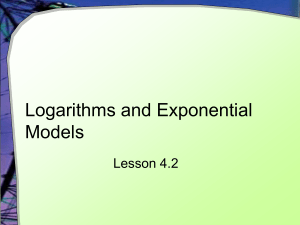Logarithmic Functions and Their Graphs (II)
advertisement
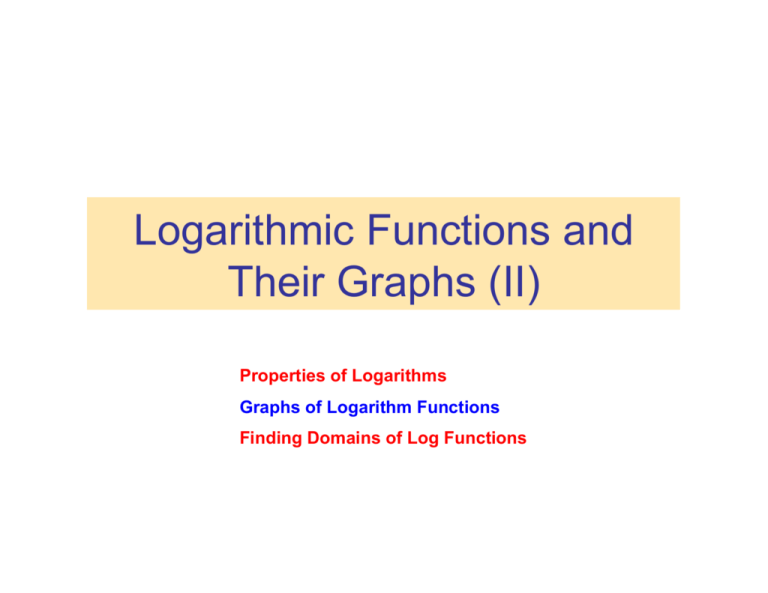
Logarithmic Functions and Their Graphs (II) Properties of Logarithms Graphs of Logarithm Functions Finding Domains of Log Functions From the definition of a logarithm we know . …. b = x equals log b x = y y Substituting the second equation’s value for y into the first equation, we get ……. b logb x =x x>0 So for the typical bases used you get ………… 10 log x = x and e ln x =x x>0 So you have the following: Basic Properties of Logarithms: Suppose that M , N, and b are positive real numbers, where b ≠ 1, and r is any real number. Then we have....... Product Rule : log b MN = log b M + log b N Basic Properties of Logarithms: Product Rule : log b MN = log b M + log b N examples of product rule : log 2 16 = log 2 8 + log 2 2 log 2 16 = log 2 4 + log 2 4 Basic Properties of Logarithms: Suppose that M , N, and b are positive real numbers, where b ≠ 1, and r is any real number. Then we have....... Quotient Rule : M log b = log b M − log b N N Basic Properties of Logarithms: Quotient Rule : M log b = log b M − log b N N examples of quotient rule : log 2 16 = log 2 32 − log 2 2 log 2 8 = log 2 32 − log 2 4 Basic Properties of Logarithms: Suppose that M , N, and b are positive real numbers, where b ≠ 1, and r is any real number. Then we have....... Power Rule : log b N = r log b N r Basic Properties of Logarithms: Power Rule : log b N = r log b N r examples of power rule : log 2 16 = 4 log 2 16 = log 2 4 2 = 2 log 2 4 = 4 The Power Rule is crucial because it lets us directly solve exponential functions. 17 x = 367 one-to-one function, so take the log of both sides log17 x = log 367 x log17 = log 367 log 367 x= ≈ 2.084333628 log17 The Power Rule is crucial because it lets us directly solve exponential functions. Power Rule : log b N r = r log b N Also from the Power Rule we get the following results ….. log b b = r r log10 r = r and ln er = r Problems using the basic properties of Logs: Writing expressions as sums & differences of logs ( ) log x 7 y11 = ⎡ (y + 7)3 ⎤ ln ⎢ ⎥= y ⎦ ⎣ ( ) log x 7 y11 = log x 7 + log y11 ( ) log x 7 y11 = 7 log x + 11(log y) 1 ⎡ (y + 7)3 ⎤ 1 3 2 ln ⎢ ⎥ = ln(y + 7) − ln y = 3ln(y + 7) − ln y 2 y ⎦ ⎣ Problems using the basic properties of Logs: Combining sums and differences of logs ⎛ x2 ⎞ 2 ln x − 3ln y = ln ⎜ 3 ⎟ ⎝y ⎠ 2 ⎡ (c − cd) ⎤ log(c 2 − cd) − log(2c − 2d) = log ⎢ ⎥ (2c − 2d) ⎣ ⎦ ⎡ (c 2 − cd) ⎤ ⎡ c(c − d) ⎤ ⎛ c⎞ = log ⎢ = log ⎢ = log ⎜ ⎟ ⎥ ⎥ ⎝ 2⎠ ⎣ 2(c − d) ⎦ ⎣ (2c − 2d) ⎦ Change of Base Formula: Very helpful to change to common or natural logs from other bases If you forget the formula it is easily derived. 1. Start with the definition of the log, then change to exponential form. 2. Now, take the log of each side of the equation. 3. Solve for y. The text’s book’s basic properties of logarithms….. 1. Put in logarithmic form 2. Exchange the x and y variables Symmetric about y = x line, property of inverse functions Log graphs contain the point (1,0) General shape of LOG graph where the base is greater than 1 The log with the smaller base will be on top. Think Why. More accurately, treats the y-axis as a vertical asymptote General shape of LOG graph where the base is between 0 than 1 The log with the larger base will be on top above the x-axis and below beneath the xaxis. Think Why. Transformations of LOG functions: Transformations of LOG functions: In General Terms ……. Exponential _ Function : f (x) = 4 x ⎛ 1⎞ f (x) = ⎜ ⎟ ⎝ 3⎠ f (x) = 10 x f (x) = e x x Exponential _ Function : f (x) = 4 x ⎛ 1⎞ f (x) = ⎜ ⎟ ⎝ 3⎠ x f (x) = 10 x f (x) = e x Domain exponential function = Range logarithmic function Range exponential function = Domain logarithmic function so, Logarithmic _ function _ Domain → x _ in _ int erval _(0, ∞) Range → y _ in _ int erval _ ( −∞, ∞ ) That does not mean the domain is always 0 to infinity, though. 1 ⎛1 ⎞ 2x − 1 > 0, so _ x > , Domain _ is _ thus _ ⎜ , ∞ ⎟ ⎝2 ⎠ 2 Problems for you ….. From pages 203 and 204 #39-65 odds
